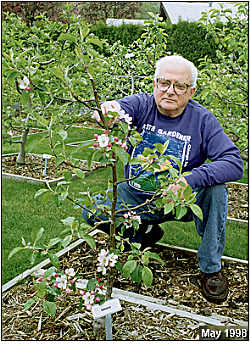Introduction – Blueberries – North Apple Bed – Panoramic View – Dwarf – Conclusion
Gene’s Answers – Train a Mini-Dwarf – Favorite Apples – Map of Backyard
At this point you probably have several questions you’d like to ask Gene. We’ve tried to anticipate them, and asked Gene to respond.

When you began, did you have such an ambitious plan for your backyard?
“No, absolutely not. I started off with a few trees at the back of my property in 1983. These were the larger dwarf types grafted on M27/M111 and a few mini-dwarfs to see what the differences were. This was about the same time I joined MidFEx. Bob Kurle told me of an orchard in Michigan that was putting apples on M27 rootstock and was selling them in pots. I went there and I think that’s when the bug bit me. I picked up M27 and the M27/M111 at the same time.”
How many apples can one of your small trees produce?
“I’d estimate my M27 and P22 can produce a quarter to a third of a bushel of full-sized apples. More than a taste, about two dozen. With my M27/M111 you will harvest one and a half to two bushels. Over 50 apples easily.”
Why don’t you grow fewer but larger dwarf trees and graft several varieties onto each one?
“Some people graft several varieties onto a single tree but I don’t. I only have one variety growing on each apple tree. If I use a piece of scion wood infected with a virus, the virus will only affect that tree itself. Each time you add a graft to a tree you increase the chance of adding a virus to the tree.”
Why do you grow only apple trees and not other fruiting trees?
“They are the only fruit trees that can be miniaturized or dwarfed effectively.”
When do you prune your trees?
“I prune my trees twice a year. Spring pruning is done while the trees are dormant. I remove branches that would overlap and rub against each other. I also prune to open up and get more light into the tree. The second time I prune is late July or August. I want to remove the additional season’s growth and hold the tree back in size.”
What do you do about spraying?
“I start with a dormant spray. It’s important because this spray smothers any overwintering insect eggs on the trees.” “Then I start spraying based on the University of Illinois Extension Service recommendation. I mix up my own spray. One benefit is I can tailor my spray. When the blossoms are open I only use a fungicide, no insecticide. That way I don’t kill any bees. Otherwise I use captan, imidan, malathion. I also strongly recommend adding a wetting agent to your spray.” “I used a backpack sprayer for years, but then I treated myself to a Hudson Suburban sprayer. It on wheels and has a gasoline engine. Some people use the sprayer that you attach to the hose; it doesn’t matter what you use, as long as you keep to a spraying program. You can use an all purpose orchard spray; it’s a powder that you add water to. That’s what I used in the begining. “I spray three times a month, stopping September 1. By this time the insects that would do any damage are almost non-existent.”
What do you do about fertilizing?
“I fertilize in the spring. I don’t worry about the grass anymore. I use a 5-5-5 or a 10-10-10. I try to fertilize lightly. My rule of thumb is to have about 8 inches of growth on non-bearing trees. If more than that, you’re feeding too much. I once used a foliar fertilizer, but I had so much new growth that I had a lot of extra summer pruning.”
How about watering?
“I try to make sure my established mini-dwarf trees get 2 inches of water each week. At the beginning I might water the transplants more frequently. You’d be surprised how strong these trees are. A mini-dwarf tree will demand more watering than a dwarf. An establish dwarf sends its roots so far out you don’t have to do anything most months except wait for rain. Now I admit I cheated a little; several years ago I treated myself to an automatic sprinkler system and I love it.”